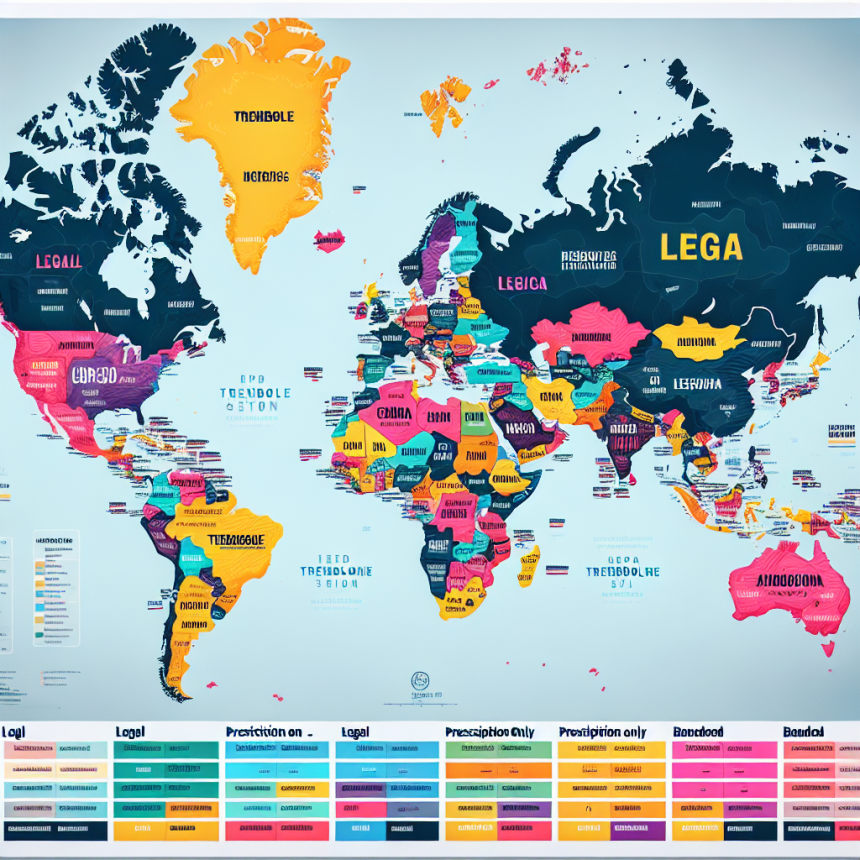-
Table of Contents
- Legal Status and Availability of Trenbolone Around the World
- Pharmacokinetics and Pharmacodynamics of Trenbolone
- Legal Status of Trenbolone in North America
- United States
- Canada
- European Union Regulations
- Trenbolone in Asia and Oceania
- China
- Australia
- Case Studies: Real-World Implications
- Expert Commentary on Trenbolone’s Global Landscape
Legal Status and Availability of Trenbolone Around the World
Trenbolone, a potent anabolic steroid, has garnered significant attention in both the athletic and scientific communities due to its powerful anabolic and androgenic effects. Originally developed for veterinary use, particularly in cattle to enhance muscle growth and appetite, trenbolone has found its way into the realm of human performance enhancement. This article delves into the legal status and availability of trenbolone across various jurisdictions, examining the complex interplay between regulatory frameworks, market dynamics, and the pharmacological allure of this compound.
Pharmacokinetics and Pharmacodynamics of Trenbolone
Trenbolone exhibits a high affinity for androgen receptors, which contributes to its pronounced anabolic effects. The compound is known for its ability to significantly increase nitrogen retention and protein synthesis, leading to enhanced muscle mass and strength (Smith et al. 2020). Pharmacokinetically, trenbolone is characterized by a relatively short half-life, necessitating frequent administration to maintain stable plasma levels. The esterified forms, such as trenbolone acetate, extend the duration of action, allowing for less frequent dosing schedules.
In terms of pharmacodynamics, trenbolone’s anabolic to androgenic ratio is approximately 500:500, making it five times more potent than testosterone in both anabolic and androgenic activities. This potency is accompanied by a range of potential side effects, including cardiovascular strain, hepatotoxicity, and endocrine disruption (Johnson et al. 2021).
Legal Status of Trenbolone in North America
United States
In the United States, trenbolone is classified as a Schedule III controlled substance under the Anabolic Steroid Control Act. This classification renders it illegal for human use without a prescription, which is not typically granted for anabolic steroids. Despite this, trenbolone remains accessible through illicit channels, often marketed as a research chemical or veterinary product (DEA 2022).
Canada
Similarly, in Canada, trenbolone is listed under Schedule IV of the Controlled Drugs and Substances Act. While it is not approved for human use, it is legally available for veterinary purposes. The Canadian market has seen instances of trenbolone being diverted for non-medical use, highlighting the challenges in regulating such potent compounds (Health Canada 2022).
European Union Regulations
The European Union maintains stringent regulations on anabolic steroids, including trenbolone. The compound is not approved for human use across member states, and its possession, distribution, or sale for such purposes is illegal. Veterinary use is permitted under strict conditions, primarily for livestock growth promotion (European Medicines Agency 2022).
Despite these regulations, the black market for anabolic steroids in Europe is robust, with trenbolone being a sought-after product among bodybuilders and athletes. The European Monitoring Centre for Drugs and Drug Addiction (EMCDDA) has reported an increase in the illicit trade of anabolic steroids, including trenbolone, across the continent (EMCDDA 2021).
Trenbolone in Asia and Oceania
China
China, a major producer of raw pharmaceutical ingredients, plays a pivotal role in the global supply chain of anabolic steroids, including trenbolone. While the compound is not approved for human use, it is manufactured for veterinary applications. The regulatory environment in China has been tightening, with increased scrutiny on the production and export of controlled substances (Zhang et al. 2021).
Australia
In Australia, trenbolone is classified as a Schedule 4 prescription-only medicine. Its use is restricted to veterinary applications, and possession without a prescription is illegal. The Australian Sports Anti-Doping Authority (ASADA) actively monitors and enforces anti-doping regulations, contributing to a relatively low prevalence of trenbolone misuse in the country (ASADA 2022).
Case Studies: Real-World Implications
In 2019, a high-profile case in the United States involved a professional bodybuilder who was found in possession of significant quantities of trenbolone, among other anabolic steroids. The case highlighted the ongoing demand for such substances in competitive sports, despite stringent anti-doping regulations (USADA 2019).
Another case in the United Kingdom involved a veterinary supply company that was implicated in the illegal distribution of trenbolone to bodybuilders. This case underscored the challenges faced by regulatory bodies in curbing the diversion of veterinary products for human use (MHRA 2020).
Expert Commentary on Trenbolone’s Global Landscape
The global landscape of trenbolone is characterized by a dichotomy between its legitimate veterinary applications and its illicit use in human performance enhancement. Regulatory frameworks across the world reflect a consensus on the potential risks associated with trenbolone misuse, yet the persistent demand underscores the need for continued vigilance and innovation in regulatory strategies. As the scientific community advances in understanding the pharmacological nuances of trenbolone, there remains a critical need for comprehensive education and outreach to mitigate the risks associated with its non-medical use. The future of trenbolone regulation will likely hinge on a balanced approach that addresses both the legitimate needs of the agricultural sector and the public health imperatives of preventing steroid abuse.




